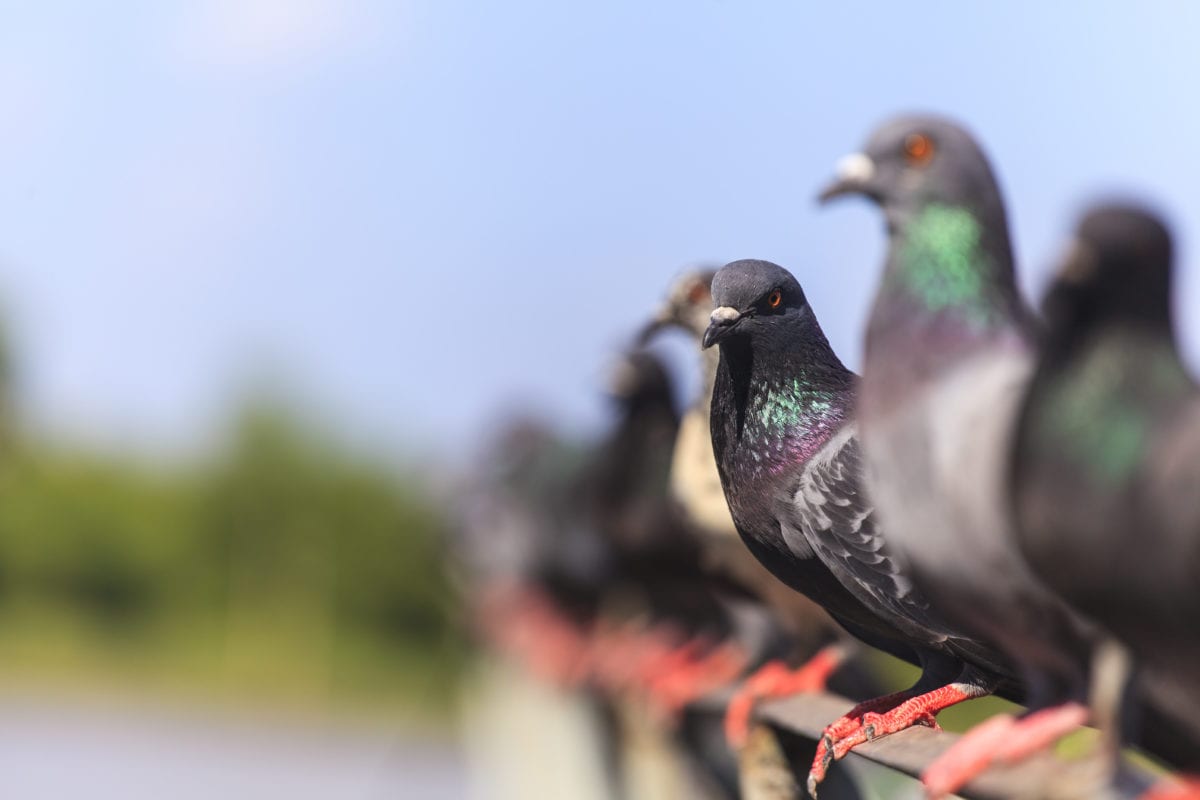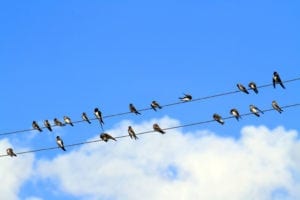I recently wrote a blog about Networks, Resistance, and Organizational Change. In it, I discuss how organizations that leverage their work with computers and technology have a network culture that runs along a hierarchical structure. Organizational leaders need to accept this reality. The more we understand networks, the more we can strategically use this knowledge to facilitate systems change.
Today I will share another aspect of how networks change and how we can become more aware of the signs that indicate the larger system is about ready to shift. Nature can teach us how to see the indicators that forecast when a shift is about to take place.
Birds Sitting on Telephone Wires
In the Midwest, we often see a flock of birds lined up across telephone wires. If we stopped and watched the flock, we would see an interesting dance before the birds all took off for their next destination. The dance follows this pattern.
After a time, one or two birds take flight. The birds that stay perched on the wire, ruffle their feathers but don’t follow. The ruffling of feathers shows they are disturbed by the birds who left. The birds that initially took off fly in a huge circle and eventually come back to perch on the telephone wire with the rest of the flock. After a little while, some more birds take off. Again, the birds who don’t follow ruffle their feathers, and again, the birds who took off fly in a circle and return to the wire.
This process of some birds taking off and circling back with time delays in between continue four to six times. The 4th, 5th, or 6th time when a few birds take off again, the rest of the flock lift off as one and follow. If we didn’t observe these birds over time, we might think the initial flights were signs of failed leadership. The birds took off, but no one followed. It is only when we observe this dynamic over time that we realize that networks, like flocks of birds, use iterations to foretell change.
Networks need time to respond and iterations in the form of new behavior can tip the system into something new – as long as we don’t give up the first time we try to influence the system.
I think of this pattern as jitter-bugging around a threshold between the current organizational state and a new organizational form. Like birds on a wire, engaging in iterations of taking off, returning, and taking off again, this back and forth between the current state and going towards something new is a pattern that can be noticed and help organizational leaders understand when their organization is transforming.

Iterations Can Foretell Change
This dance of change is found in living organizations. Often, individuals model a shift or change in the way they do something. Each time there is a break from a traditional default it causes a flutter in the rest of the organization. These experimenters often take off and return to the original way of doing things when they see they don’t have the support of their colleagues.
However, if these individuals continue to experiment with change, each time they “take off” a few more colleagues go with them. Eventually, over time, the whole organization shifts.
These dynamics of change are almost invisible if we don’t watch change evolve over time. Our traditional perspective on organizational change is that it is planned, implemented, and rolled out in a defined linear time frame. The expectation is that successful change initiatives happen the first time we try it. If no one follows the first time, or we encounter resistance, we think we have failed. What we fail to understand is that networks need time to respond.

In networked living organizations change is always happening. They are dynamic by nature. Seeing and intentionally using iterations to influence organizational change can be an effective and efficient change strategy. When we use iterations as a change strategy, we assume that the organization and the people in them need time to respond. Giving the organization time to adjust and adapt to change instead of driving change along a tight timeline, paces the nature of the network. It can allow the organization to continually adapt instead of the typical processes of alternating between change and static state.
Iterations invite leaders to see change differently. Instead of saying, we tried that before, and it didn’t work, we would say, “we’ve only tried that once, let’s try it a few more times to allow the network time to respond to the change we need.” The process of fluctuations (a few birds taking off) repeated over time eventually triggers large-scale change. The reason we have missed this dynamic is that we are impatient. We believe that change should occur quickly. However, if we are patient and persistent, we can be like those birds on a wire, triggering fluctuations that eventually shift the system.
Dr. Kathleen E. Allen writes a blog on leadership and organizations that describes a new paradigm of leadership that is based in lessons from nature and living systems. She is the author of Leading from the Roots: Nature Inspired Leadership Lessons for Today’s World (2018) and President of Allen and Associates, a consulting firm that specializes in leadership, innovation, and organizational change. You can sign up for her blog on her website: www.kathleenallen.net







I had to laugh out loud about this one. Just talking with some friends about the concept of the birds on the wire…. Love your blog. Looking forward to hearing you talk on the 16th of October!
Thank you! Our university is going through changes and this story encourages me to be more patient.
Love this!